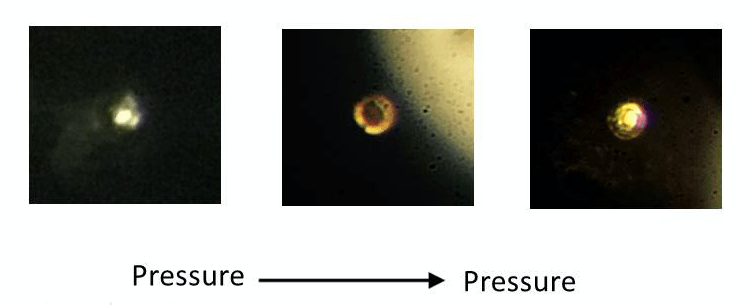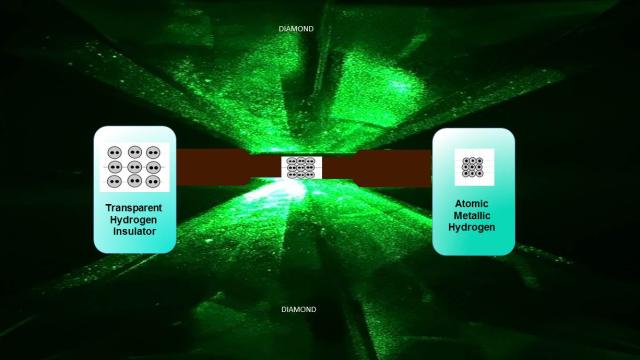The more scientists achieve the same result, the more robust that result is. On the flip side, there’s reason to be sceptical when a single group claims to make a discovery based on a single observation.
Image credit: R. Dias and I.F. Silvera
One of yesterday’s biggest headlines was the announcement that scientists had achieved a feat they’d been attempting for over 80 years: Turning hydrogen into a metal. But other scientists are already expressing doubt over the researchers’ claims.
The observation was made by a team of Harvard researchers, while they were squeezing hydrogen between diamonds at temperatures just above absolute zero, 5.5 Kelvin or -267C. As the scientists cranked up the pressure, they observed transparent hydrogen turn black. Finally, at a pressure five million times our own air pressure, the hydrogen turned reflective. The researchers presented this as proof that the hydrogen atoms had arranged into a regular, 3D structure like a metal, a behaviour first predicted by physicists Hillard Huntington and Eugene Wignerin in 1935.
Observing a metallic form of hydrogen would be important not only because it would solve a longstanding scientific mystery, but for the material’s potential. The authors say metallic hydrogen would be “important for solving energy problems and can potentially revolutionise rocketry as a powerful propellant” in their paper published online in the journal Science yesterday. Such a material would be metastable, meaning it would stay metallic as the pressure that originally forced it into a solid state came down, until some other outside influences turned it back into regular hydrogen.
Metallic hydrogen would also have important planetary science implications — Jupiter is theorised to have a metallic hydrogen core, which the Juno spacecraft hopes to detect, according to NASA.

Image credit: R. Dias and I.F. Silvera
But this isn’t the first time scientists claimed to have discovered metallic hydrogen. German scientists also made that claim in 2012, to much criticism. Those researchers regretted the boldness of their announcement, and later said the paper should have read that they “might have” created metallic hydrogen, reported Nature. Issues similar to those that caused scientists to question the German discovery are also showing up in the Harvard scientists’ paper.
“I don’t think the paper is convincing at all,” Paul Loubeyre, a physicist at France’s Atomic Energy Commission in Bruyères-le-Châtel, told Nature regarding the newest announcement.
The physicists Nature interviewed more or less said, “OK, you’re gonna tell me that just because your sample turned shiny once, now it’s a metal? Try again, sweetie.” They think the reflectivity could just as easily have come from the aluminium oxide coating the diamonds acting differently under extreme pressure. Other researchers observed that the Harvard group only took one detailed measurement. How many times do scientists have to remind one another that findings should not be presented as fact before multiple groups take repeated measurements and come up with the same results?
“You make such a big and bold claim,” physicist Eugene Gregoryanz from the University of Edinburgh School of Physics and Astronomy told the New York Times. “Why didn’t you repeat the experiment?”
The hydrogen sample is still sitting in the experiment, waiting for further experimentation, according to Nature.
